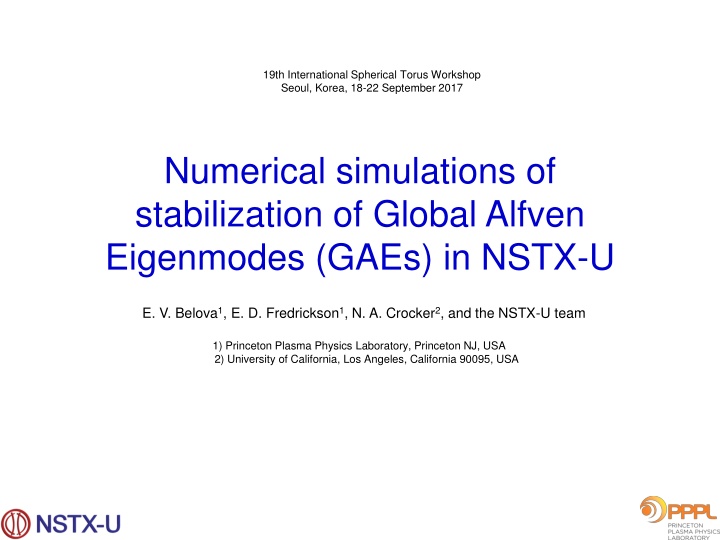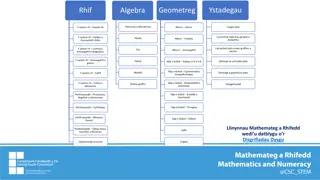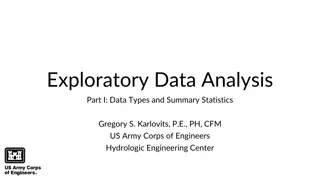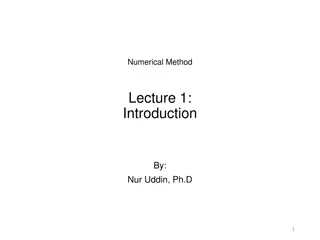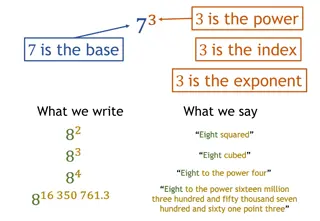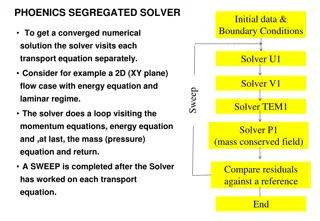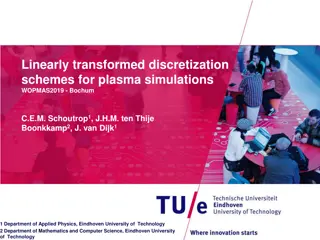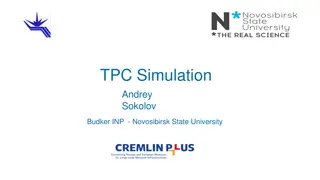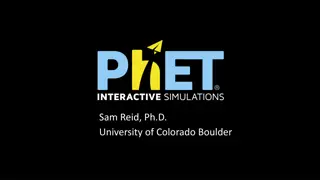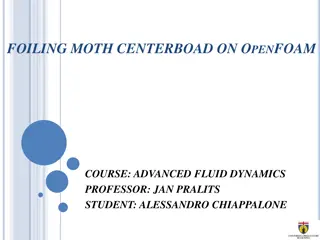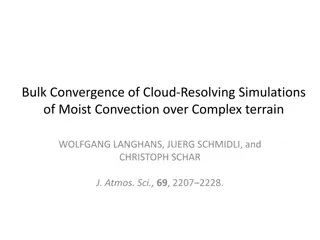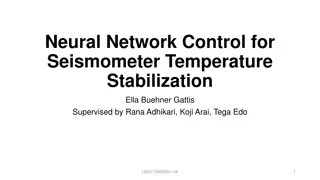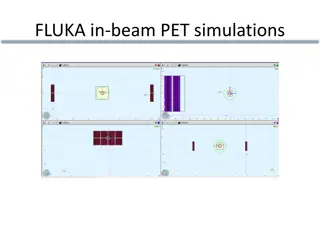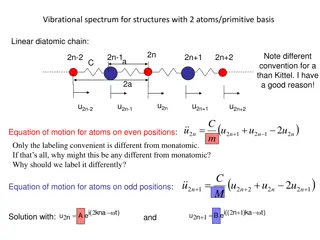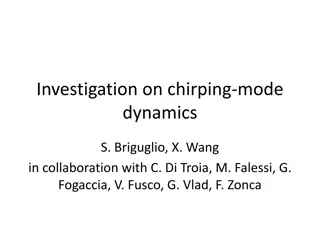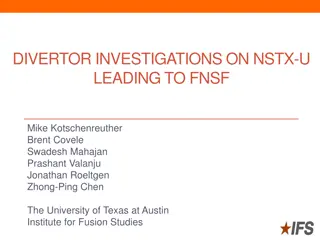Numerical simulations of stabilization of Global Alfven Eigenmodes (GAEs) in NSTX-U
Spherical Torus Workshop in Seoul focused on suppressing Global Alfven Eigenmodes (GAEs) using off-axis neutral beams in NSTX-U, with observed correlations between GAE activity, electron temperature profile flattening, and implications for fusion devices. The HYM Hybrid and MHD code description includes applications like resistive MHD, Hall-MHD, and hybrid simulations of spheromak merging.
Download Presentation

Please find below an Image/Link to download the presentation.
The content on the website is provided AS IS for your information and personal use only. It may not be sold, licensed, or shared on other websites without obtaining consent from the author.If you encounter any issues during the download, it is possible that the publisher has removed the file from their server.
You are allowed to download the files provided on this website for personal or commercial use, subject to the condition that they are used lawfully. All files are the property of their respective owners.
The content on the website is provided AS IS for your information and personal use only. It may not be sold, licensed, or shared on other websites without obtaining consent from the author.
E N D
Presentation Transcript
19th International Spherical Torus Workshop Seoul, Korea, 18-22 September 2017 Numerical simulations of stabilization of Global Alfven Eigenmodes (GAEs) in NSTX-U E. V. Belova1, E. D. Fredrickson1, N. A. Crocker2, and the NSTX-U team 1) Princeton Plasma Physics Laboratory, Princeton NJ, USA 2) University of California, Los Angeles, California 90095, USA
NSTX-U off-axis neutral beam suppresses Global Alfven Eigenmodes (GAEs) [E. Fredrickson, PRL 2017] frequently observed in the sub-cyclotron frequency range of 0.1fci up to 0.5fci, in NSTX and NSTX-U. Driven by cyclotron resonance with beam ions. New neutral beam sources -> ability to control the fast ion distribution. Off-axis neutral beams inject fast ions onto trajectories largely parallel to the magnetic field, with pitch 0.8<V||/V<1. Reliable suppression of the counter- propagating GAE when an additional 1.3MW is injected using the outboard beam. GAE stabilization has been well documented for many shots. Counter-propagating GAEs are
3 Correlation between strong GAE/CAE activity and flattening of the electron temperature profile has been observed in NSTX [Stutman, PRL 2009] Intense GAE/CAE activity (0.5-1.1MHz). Flattening of Te profile with - increased beam power; - beam energy scanned between 60 and 90 keV [Stutman, PRL 2009]. Was attributed to - enhanced electron transport due to orbit stochasticity in the presence of multiple GAEs [Gorelenkov, NF 2010]. - energy channeling due to CAE coupling to KAW [Belova, PRL 2015]. Anomalously low Te potentially can have significant implications for future fusion devices, especially low aspect ratio tokamaks. Correlation between GAE activity, Te flattening, and central electron heat diffusivity e in NSTX H modes with 2, 4, and 6MW neutral beam.
HYM HYbrid and MHD code Code description Applications 3-D nonlinear. Physical models: - Resistive MHD & Hall-MHD - Hybrid (fluid electrons, particle ions) - MHD/particle (one-fluid thermal plasma, + energetic particle ions) - Drift-kinetic particle electrons Full-orbit kinetic ions. For particles: delta-f / full-f numerical scheme. Parallel (3D domain decomposition, MPI) NSTX - Sub-cyclotron frequency Alfven eigenmodes (GAE and CAE) ICC Theory and Modeling - Hybrid simulations of spheromak merging - FRC: Effects of beam ions on stability - Rotation control - n=2 rotational and n=1 wobble modes
5 Self-consistent MHD + fast ions coupling scheme Background plasma - fluid: Fast ions delta-F scheme: V dt x d d = + = j j B E j ( ) ( ) v p n b b dt v d = + E j v B = = B + + E B V B j A dt 0 = = / w F F A = p E / t - particle weight j B (ln ) d F dw = 1 ( 0 ) w = 1 / 1 / V / t ( ) t p dt dt = V / ( ) F = ( , , ) F p 0 0 , V and p are thermal plasma density, velocity and pressure, nb and jb are beam ion density and current, and nb << ne is assumed.
6 Self-consistent anisotropic equilibriumincluding the NBI ions Grad-Shafranov equation for two-component plasma: MHD plasma (thermal) and fast ions [Belova et al, Phys. Plasmas 2003]. = R z , ) H ( + ) G ( B h z R 2 1 + = + 2 R R p H H G H RJ = G + , G poloidal stream function ( , ) h J R z b 2 R R = bp Beam effects Modifications of equilibrium due to beam ions: - more peaked current profile, - anisotropic pressure, - increase in Shafranov shift might have indirect effect on stability. Beam P P || P
7 Fast ions delta-f scheme: F0=F0( , ,p ) Equilibrium distribution function F0 = F1(v) F2( ) F3(p ,v) 1 + = ( ) , for F v v v 1 0 3 3 * ( v v = 2 2 ( ) exp( ) / ) F 2 0 p ( v ) p 0 = ( , ) for , F p v p p 3 0 ( ) R p 0 0 0 where v0 = 2-5vA, v*= v0 /2, = B0/ pitch angle parameter, 0= 0.5-0.7, and = 0 + 1 includes first-order corrections [Littlejohn 81]: v 2 v v ( ) ) b 0 || = ( 2 ] c d [ b b a 2 2B B = = v v c a . c magnetic is gradient curvature and drift velo city, / , v b d Parameters are chosen to match TRANSP beam profiles.
8 HYM simulations reproduce frequency range of unstable GAE and CAE modes observed in NSTX Experimental analysis: Detailed measurements of GAE and CAE amplitudes and mode structure for H-mode plasma in NSTX shot 141398 [N. Crocker, NF 2013]. CAEs: f>600 kHz, and |n| 5. GAEs: f<600 kHz, and |n|~6-8. Co- and counter-rotating CAEs with f~1.2- 1.8 MHz, and n=6-14 also observed in the same shot [E. Fredrickson, PoP 2013]. - HYM - Experiment CAE ci GAE |n| Frequency versus toroidal mode number for unstable GAEs (red) and CAEs (blue), from HYM simulations and experiment, fci=2.5MHz. HYM simulations: For n=5-7 most unstable are counter- rotating GAEs, with f= 380-550 kHz. For n=4 and n=8, 9 most unstable are co- rotating CAEs with f= 870-1200 kHz.
Simulations have been performed to study the excitation and stabilization of GAEs in the NSTX-U HYM - - - - TRANSP Simulations using the HYM code have been performed for NSTX-U shot #204707 right before (t=0.44s) and shortly after (t=0.47s) the additional off-axis beam injection. Plasma and beam profiles have been chosen to match TRANSP profiles for t=0.44s and t=0.47s. The beam ion distribution function matches TRANSP data, with pitch distribution in the form Fb~ exp[-( - 0( ))2/ ( )2]. q( ) nb/n0(R) t=0.44t=0.47 0.3 0.5 1.0 1.5 R(m) (a) Spectrogram on magnetic fluctuations (n=8-11 counter-GAEs). (b) Rms magnetic fluctuations; (c) Injected beam power. Plasma shape, q- and nb profiles for NSTX-U shot 204707 t=0.44 from TRANSP and HYM GS solver + FREE_FIX.
HYM reproduces experimentally observed unstable GAEs HYM #204707 t=0.44 Simulations reproduce most unstable toroidal mode numbers and GAEs frequencies. HYM overestimates growth rates compared experimental analysis Growth rates are sensitive to distribution function parameters resonance particles are in tail of distribution. / ci / ci n (a) Growth rates and (b) frequencies of unstable counter-GAEs from HYM simulations for t=0.44s. Blue line is Doppler-shift corrected frequencies, points experimental values. t=0.44t=0.47 (a) Spectrogram on magnetic fluctuations (n=8-11 counter-GAEs). (b) Rms magnetic fluctuations; (c) Injected beam power.
NSTX-U simulations: n=10 counter-GAE (t=0.44s) dB dB|| R(m) R(m) Radial profile of B and n for n=10 counter-GAE. Radial profile of A/ ci for n=10, m=0-2; location of GAE. Unstable modes are counter-rotating and have shear Alfven polarization. Located near min of A.
Improved Fbeam fit reduces growth rates ( 2 2 ~ exp( ( )) / ( ) ) Fbeam v v 0 cyclotron resonance F/F V||/V V||/VA (a)TRANSP fast-ion distribution before the outboard beam injection t=0.44. Estimated dr~0.5% ci for n=11 GAE; (b)HYM fast-ion distribution from n=-10 GAE simulations, dr~1.5% ci. Dots show resonant particles. (a)Location of resonant particlesin phase space: = B0/ vs p . (b) Particle weight w ~ F/F vs orbit- averaged parallel velocity. Particle color corresponds to different energies: from E=0 (purple) to E=90keV (red).
Off-axis beam injection strongly suppresses all unstable GAEs TRANSP fast-ion distribution before and after the outboard beam injection. Fast ions with pitch v||/v~1 are responsible for GAE suppression.
HYM simulations reproduce experimental finding: off-axis neutral beam injection reliably and strongly suppresses unstable GAEs The beam ion distribution function with pitch distribution in the form Fb~ exp[-( - 0( ))2/ ( )2]. Additional of-axis beam injection modeled by adding beam ions with distribution Fadd~ exp[- 2/ a( )2], i.e. with 0=0, a< and about 1/3 of the total beam ion inventory. HYM shows complete stabilization of n= 7-12 counter-GAEs by additional off-axis beam injection. HYM #204707 t=0.47 |dB |2 t=0.44s t=0.47s t ci Time evolution of magnetic energy of n=10 GAE from HYM simulations for t=0.44s (red), and t=0.47s (blue).
15 Summary and Future Work HYM simulations show range of toroidal mode numbers, and frequencies of unstable GAEs that match the experimentally observed GAEs in NSTX-U. Growth rate of GAE is sensitive to details of beam ion distribution. Simulations reproduce experimental finding, namely it is shown that off-axis neutral beam injection reliably and strongly suppresses all unstable GAEs. A robust physical mechanism for stabilizing GAEs - threshold for stabilization for additional beam is less than 25% of total beam power. Future work: Understanding instability conditions for excitation of counter-GAEs comparison with analytical condition. Bulk plasma rotation and Hall term can have effect on GAE stability and mode structure. Comparison with experimental results including mode structure, saturation amplitudes and etc for several shots.
